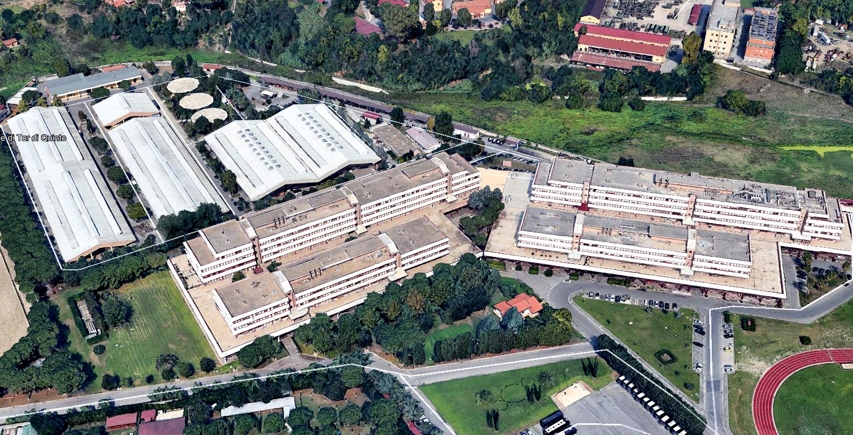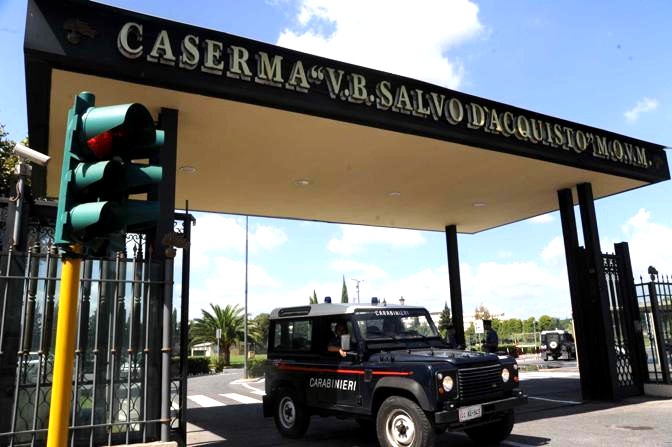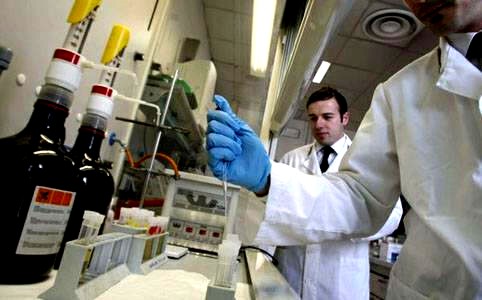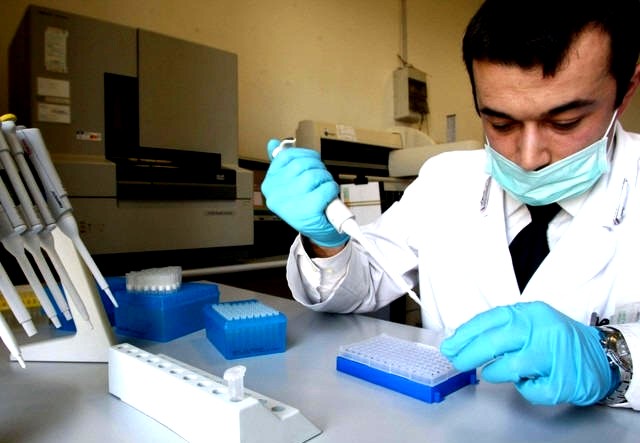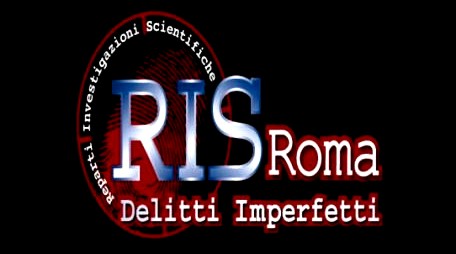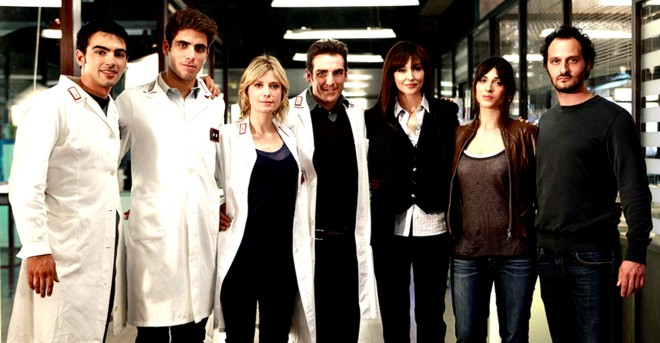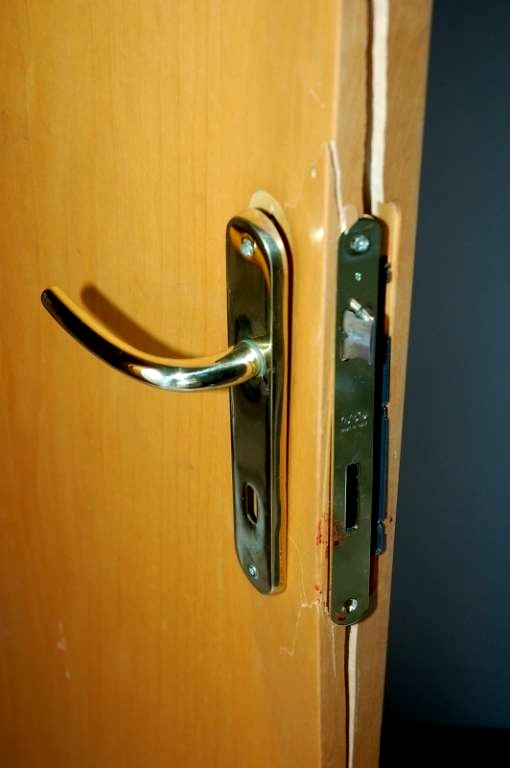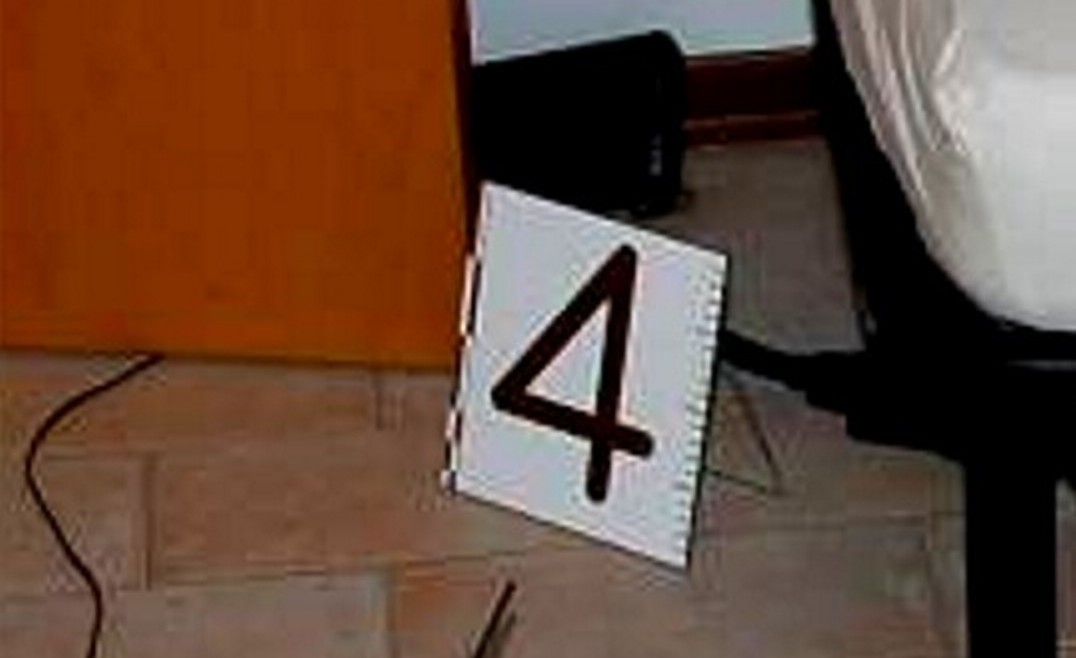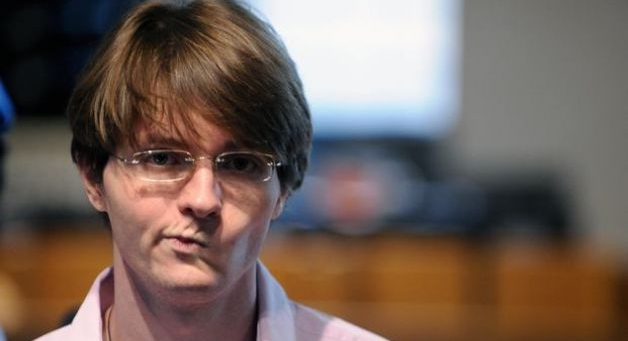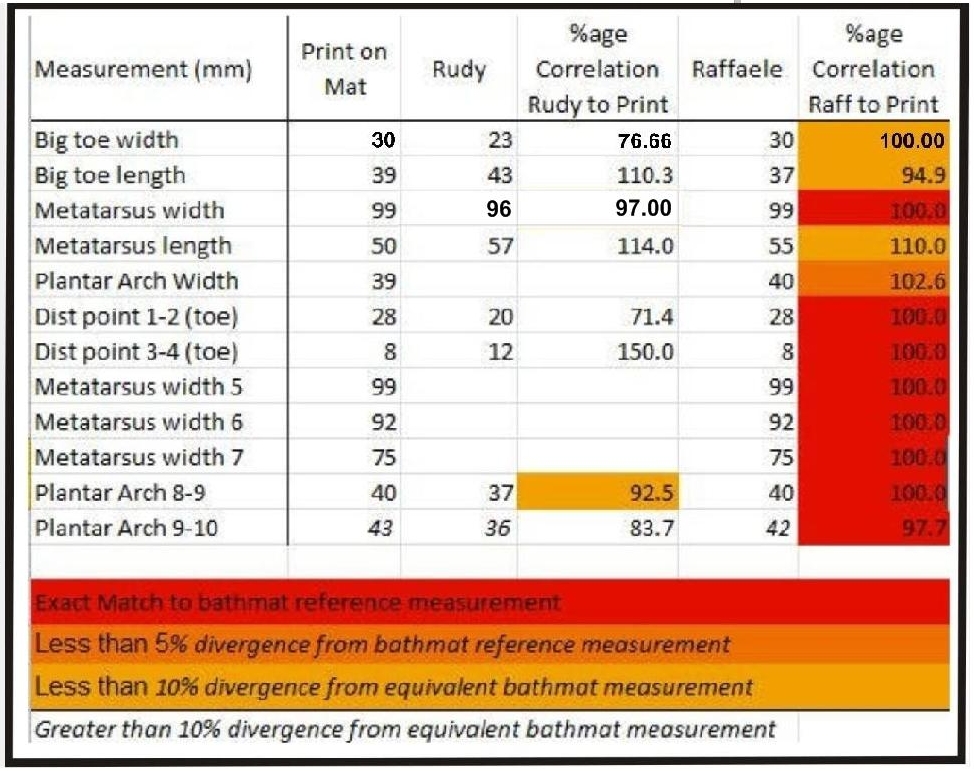
Political & economic headsup: US is demonstrating unsorted systems problems in spades. Do watch your investments. As Washington DC policy gets more & more off-target, big New York investors are betting very heavily that stocks will soon crash. Gross systems mismanagement 2017-20 tanked stocks several times.
Category: DNA and luminol
Monday, October 14, 2013
DNA Tests: Umbria24 Reporter Francesca Marruco Provides A Balanced Overview Of Possible Prospects
Posted by ziaK
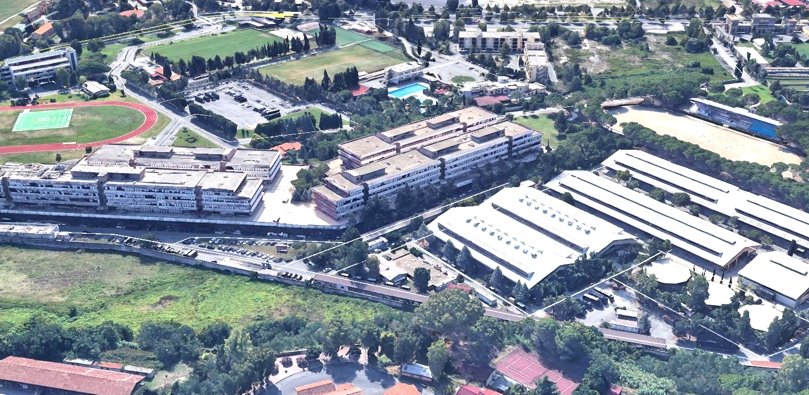
It may be that today or any day this week a definitive analysis of the seeming mixed DNA sample appears from an authoritative source.
Perugia-based Francesca Marruco did a lot of careful balanced reporting from Perugia early in the case. She has excellent official sources. She suggests in this report that the world might have to wait for the last day in October (deadline for the labs to report their analysis) or 6 November (next scheduled court session) for the official bottom line.
This is my translation. I am Italy-based also.
Kercher trial: unconfirmed reports on Amanda’s DNA: The experts will lodge their report [their truth] on the 30th [October]
By Francesca Marruco
The “I” trace identified on the blade of the knife could have come from the American woman, however the data could lend itself to contrary interpretations. The sentence could arrive before 30 November.
In order to obtain the definitive results of the analyses that the carabinieri of the RIS in Rome are carrying out on the “I” trace identified on the blade of the knife which is considered to be the weapon with which Meredith Kercher was murdered, we will have to wait until 30 October - the day on which the experts appointed by the Assise Appeal Court of Florence will lodge their conclusions. Already on Friday, the day on which the analyses were begun in the experts’ laboratories, uncomfirmed reports began to be leaked concerning the origins of that tiny quantity of DNA.
These leaks would like to ascribe it [the DNA] to Amanda Knox, the American student who was initially convicted and subsequently acquitted for the homicide of her flatmate, Meredith. But there is, as yet, neither certainty nor officiality, and - as this long case has taught us - even in the presence of officiality, opposing interpretations may be formed. If, in fact, as is being rumoured, those tiny biological particles did actually belong to Amanda Knox, this information could be interpreted in many ways.
Opposing interpretations - The defence would hasten to say that since Amanda had spent time in Raffaele Sollecito’s house - where the knife was discovered - there would be nothing strange if her DNA were to be on the blade. Just as - and this, at least, has been clearly seen - Amanda’s DNA was found on the handle of the weapon. Its presence could be explained by any banal procedure in the kitchen.
And indeed, Knox’s own defence has always maintained that the highly-contested trace “H” - the other trace identified on the blade, and which according to some is Meredith’s DNA - is nothing more than potato starch. Thus, Amanda would seemingly have left her trace on the knife while peeling potatoes.
Traces - It is very clear, however, that the Prosecution could claim that precisely that presence of Amanda’s DNA on the blade of the knife could be proof that Knox touched it. To peel potatoes, or to kill her flatmate Meredith, as the Prosecution holds? If it is confirmed, one can bet that the data [found by the RIS] will give rise to an “earthquake” and it will fall to the judges of the Florentine court to clear up the resuting debris.
On the other hand, they might decide not to consider it [the data] any more than the other elements [of evidence], since it effectively lends itself to a multiplicity of [possible] interpretations which cannot be confirmed at this point in time. Certainly, if that trace were that of the victim, Meredith Kercher, the proceedings might take a different direction, since there would then be two [traces] at that point, and not just one trace of the victim’s DNA which would have ended up on the blade of a knife which she never touched during her lifetime.
The certainties, or rather, the conclusions, of the experts will be lodged on 30 October. It is the 6th of November, however, which has been appointed for the hearing during which these results will be discussed before the Court and the parties.
Towards the verdict - Raffaele Sollecito may also be present in court on that date, as he announced via his lawyers, Giulia Bongiorno and Luca Maori. Sollecito intends to make various spontaneous declarations in order to affirm once again his non-involvement in the barbarious murder of Meredith Kercher, for which only Rudy Hermann Guede is currently in jail, with a sentence of 16 years in prison which has been confirmed[by the Supreme Court].
After the hearing in which the results of the tests entrusted to the Rome RIS will be discussed, it is very probable that the trial will travel rapidly towards sentencing - the fifth sentence pronounced by an Italian court with regard to Raffaele Sollecito and Amanda Knox. The Court President [leading judge], Alessandro Nencini, said during the first hearing that “this is a trial for matters of undeniable seriousness. Over and above the media circus, is Court’s desire to give all parties the most space possible for discussion, because there was a very significant sentence/conviction originally.”
By November - For this reason, “in order to obtain every possible factor for the matter we are trying here, the Court orders that the trace should be examined by the staff of the RIS in Rome”. The Florence Court’s sentence could thus arrive by the end of November, or at the latest by the end of the year. It is very unlikely that Amanda Knox will decide to be present at any of the hearings, and probably she will await the verdict in Seattle.
Perhaps the final word shall never be pronounced on the most Press-covered trial in Italian legal history. After this latest sentence, in fact, nothing prevents anyone from making further appeals to the Supreme Court.
Friday, October 11, 2013
The Carabinieri Laboratories In North-Central Rome Where Now Two Different Samples Need Attribution
Posted by Peter Quennell
Third update
Italy-based freelance reporter Andrea Vogt has tweeted the following: Leaks suggest DNA on knife shows knox genetic profile, but there is another profile being studied. Too early to interpret
Second update
Excellent comment on PMF by the poster Hugo which explains how the balance hasn’t changed.
The song remains the same. The republic contends that Amanda Knox used that knife to murder Meredith Kercher. The knife has yielded the DNA of just two people: Knox, in a position which indicates that she was gripping it, and Meredith, in a position which indicates that she was stabbed with it.
The defence can easily claim that Knox’s trace results from normal culinary use (although Stefanoni said the handprint indicated an atypical stabbing grip, with the knuckles on the same side as the blunt edge of the blade, and not a normal culinary cutting grip, with the knuckles on the same side as the sharp edge).
The problem is Meredith’s DNA at the sharp end. ‘Independent court-appointed expert’ Carla Vecchiotti admitted on the stand that this could not have arisen from laboratory contamination.
Professor Christopher Halkides’ suggestion that the contamination occurred during collection, because Stefano Gubbiotti acquired Meredith’s ‘aerosol DNA’ on his clothing, when he was supposedly in the house the same day, almost a week after the murder, and thus transferred the DNA from his clothing to his fingers to his evidence-handling gloves to the knife when he took it from Finzi’s envelope and re-packaged it in a stationery box at the Questura, is self-evidently absurd, fanciful, fictional and completely outwith the realms of actual forensic science.
And it’s not in evidence anyway, so it’s not an option open to the court.
Plus the objection to low copy number DNA is an American superstition not recognised in Europe. Unusually, it’s a scientific area where the US lags well behind. So you get hillbillies like Bruce Budowle grumbling, ‘Cain’t rightly say what that there newfangled LCN is, but ah reckon ah’m agin it.’ You’ll recall that a British appeal court has found that Bruce Budowle hasn’t the faintest idea what he’s talking about and also that, like Halkides, he tends to cite sources that don’t actually say what he says they say.
Knox is there on the hilt of the knife. And M is there near the point of the blade, and she’s trying to tell us something.
First update
The gap between the blade and handle of the knife was apparently widened to obtain the sample for the test. Sollecito lawyer Maori has claimed it is Amanda Knox’s. It is apparently adjacent to her previous trace.
If that is the case, the strength of the DNA evidence (which is very strong) remains unchanged. Dr Stefanoni identified Exhibit 36 on the blade as a strong trace of Merediith’s DNA. This was supported by various experts.
No contamination of that trace has ever been proved - or even a convincing contamination scenario put forward - and the video on top of the post below shows how the DNA charts for the sample and for Meredith totally match.
First post
Human DNA is widely reported in Italy to have been established from the sample never before tested on the large knife.
We may have to wait on an announcement from Judge Nencini in Florence as to whose DNA it is. That may not happen today.
These labs in the Carabinieri barracks are not far from the center of Rome. They are very well know to Italians because (images at bottom) “RIS” the Italian version of the show “CSI” is set there.
Thursday, October 10, 2013
Testing Of The DNA Sample Starts Today Though Possibly No Results Announced Before 6 November
Posted by Peter Quennell
1. ViaDellaPergola’s video
That video from 2010 illustrates how the existing positive tests described in the Massei Report were crystal-clear; subsequently Hellmann, Zanetti, Conti and Vecchiotti (all now being investigated) so muddied the water.
2. From our short-form Massei Report
This is from Part Three of the four-part abbreviation of the Massei Report done by Skeptical Bystander and a PMF team in mid-2011.
Exhibit 36: The double DNA Knife
Exhibit 36 is a 31 cm long knife with a 17 cm blade and a dark handle. It was seized from the kitchen cutlery drawer at Raffaele Sollecito’s home, located at 110 Corso Garibaldi in Perugia, on 6 November, 2007 when Chief Inspector Armando Finzi was ordered to perform a search of Sollecito’s residence. This exhibit is important because “Sample 36b” taken from a scratch on the knife blade yielded Meredith Kercher’s biological profile.
After putting on gloves and shoe coverings, Finzi and his team entered the home. They noted a strong smell of bleach. Opening the cutlery drawer, they saw a big, “extremely clean” knife. In Sollecito’s bedroom they found a second knife. The knives were bagged and sealed.[106]
Exhibit 36 was carried back to the police station, where it was placed in a box for shipping to the Polizia Scientifica in Rome. Dr. Stefanoni was the recipient of the box containing the knife in Rome. All parties testified that standard procedures were followed to avoid the risk of contamination.
On 4 November, 2007, Meredith’s roommates Filomena Romanelli, Laura Mezzetti, and Amanda Knox had been taken by the police to look at the knives in their kitchen at the apartment in Via della Pergola. Personnel from the Questura reported Amanda’s “severe and intense emotional crisis, unlike [the reaction of] the other two girls”.[292] This behavior was contrasted to Amanda’s behavior at Police headquarters two days earlier:
“This circumstance appears significant both in its own right and also when one considers that Amanda had never previously shown signs of any particular distress and emotional involvement (in the Police headquarters, on the afternoon of November 2, Meredith’s English girlfriends, Robyn Carmel and Amy Frost in particular, according to their declarations, had been surprised by the behaviour of Amanda, who did not show emotions).”[292]
Investigators’ attention was alerted to the Exhibit 36 knife because of Amanda’s inconsistent behavior. Later, police overheard a jail conversation between Knox and her parents on 17 November, when Knox said, “I am very, I am very worried about this thing with the knife ... because there is a knife of Raffaele’s ...”.[292]
Exhibit 36 thus became a central piece of trial evidence. The debate would subsequently be focused on two issues: The compatibility of the knife with the large stab wound in Meredith’s neck; and the reliability of the DNA analysis.
Considering the first of these points, although the knife blade is 17 cm long, the depth of the larger wound is just 8 cm . This “discrepancy” was the basis of defense efforts to discredit the knife as a murder weapon. The compatibility of the Exhibit 36 knife and the larger of Kercher’s wounds is addressed by Professor Bacci (see p. 121 of the Massei report). Professor Norelli maintains that “it is not said that a blade is always embedded (plunged into) the target right up to the handle; the blade may also go (in) only to a certain portion of its length, and not right up to its end”.[126]
It is noted that the movements of the victim may have played a part in determining the depth of the cuts. “If I insert a centimeter of the blade into the victim and the victim suddenly moves towards me, how much of the blade will be driven inside the body surface area is absolutely unpredictable and depends on the action of both”.[129] Alternatively, the blade of the knife might have met an obstacle. The cutting action is described on p. 146 and again starting on p. 152.
Defense witness Dr. Patumi disputed the compatibility of the wounds with said knife, arguing that a blade of 17 cm length could not have caused a cut 8 cm deep; see p. 156-157. However, the Court rejected “the thesis of the incompatibility of the most serious wound and the knife Exhibit 36”, holding this thesis to be “unacceptable” .[172]
Regarding the second point ““ that of the DNA analysis ““ Dr. Stefanoni was the responsible expert at the crime lab in Rome. Although no biological traces were visible to the naked eye on the face of knife blade, Dr. Stefanoni perceived scratches - “anomalies in the metal’ - on the blade when rotating the blade under strong lighting. The streaks were:
“... visible under good lighting by changing the angle at which the light hit the blade, since obviously the blade reflects light and thus creates shadows, making imperfections visible.”[196]
Sample 36b was taken from one of these points on the blade. The genetic profile of Meredith Kercher was identified from this sample. Stefanoni presented charts to the court, showing the DNA profile: she noted “that the peaks were a bit low, but that without doubt were still within the range that is considered useful for testing a specimen (page 108). Although of a much lower quantity of DNA, the profiles were nonetheless very present and, by making a comparison with Meredith’s profile, Dr. Torricelli reported that “šwe find all the alleles, and we find them to be equal to those obtained from the swab taken, from the sample taken from the wound. Therefore in this case too, without doubt”› -she continued- “šalthough we are confronted with a sample that contains very little DNA, it nonetheless contains the DNA of only one person and is therefore comparable to Meredith’s; with regard to this knife, I would say I have no doubt in interpreting it: specimen A with Amanda’s profile and specimen B with the profile, compatible with that of Meredith.”[231-32] However, the amount of DNA was small and it was all used up in order to run a single test.
The defense objected that it was impossible to evaluate whether the actual nature of Sample 36b specimen:
“.. when we have a small amount of DNA we talk about low copy number DNA, and that when this type of DNA is present, we are indeed able to carry out our amplification and obtain a profile, but we must remember that we may have lost one of the alleles, we may have an allelic imbalance ... it becomes very difficult to distinguish from a real allele, so that when working on ... small quantities of genetic material, it is necessary to be very cautious in interpreting the results.”[237]
To this point, Dr. Stefanoni argued that it is preferable “to know to whom a biological specimen is attributable, rather than ascertaining the nature of that specimen, without attributing it to anyone.”[288]
Furthermore, it was argued by the defense that the quantity of DNA was too low to be able to perform the tests and consider the results reliable. Given a low amount of DNA, the risk of contamination is high - particularly given the very numerous number of samples being analyzed.
The court rejected the possibility of contamination because no anomalies were ever identified in the Polizia Scientifica’s analytical process. The Prosecutor pointed out that all tests had been carried out in the presence of a lawyer/consultant for the defense - who had raised no objections during the testing. The possibility of contamination during the collection of evidence was rejected based on a detailed consideration of the collection process.
Thus, the DNA from Meredith which was found on that knife cannot be traced back to any contamination occurring in the house in which it was found, or to the method of acquisition of the knife on the part of Finzi, or even to the collection and dispatch methods used by Gubbiotti. In addition, as has been said, that such contamination could have been carried out by the laboratory is also ruled out.[266]
In addition, Dr. Stefanoni testified that she did have the biological profile of the defendants, but did not employ them while interpreting the electrophoresis diagrams. Nevertheless, the Massei report judges that:
“... the main criticisms advanced by the defense concerned precisely this very small DNA quantity, and it raised the question of the reliability of the result obtained.”[288]
To this central point, Dr. Stefanoni:
“Regarding the too low quantity of DNA, Dr. Stefanoni declared, as has been seen, that even in the case of a particularly scanty amount of material, the analysis and evaluation should be performed, and she added that, if the data that emerges is absolutely readable and interpretable and the correct laboratory practice was followed, the result is reliable and there is no reason to repeat the test.
“It does not follow ... that the data is unusable and unreliable as a consequence of a lack of repetition due to a lack of further quantities of DNA. It is necessary, instead, to take account of the data that emerges from such a specimen and to check for the ““ possible ““ presence of other elements, both circumstantial and inherent to the data itself that, despite the lack of repetition of the analysis, could allow an evaluation of the reliability of the analysis and of its outcome.”[289]
The court concluded that the biological profile that resulted from the 36B DNA analysis ...
“... gave a biological profile attributable to the person who was mortally wounded with that very knife: a result, therefore, that was entirely reasonable and consistent with the event; [it was] certainly not explainable as a mere coincidence, and it must be ruled out ““according to what has already been observed in this regard - that it could have originated from contamination or from the use of a suspect-centric method.”,[290] and that
“”¦. it should therefore be affirmed that the analysis of trace 36B, which detected the presence DNA attributable to Meredith, appears to be completely reliable.”[293]
3. TJMK posts on the latest DNA science
1. Poster Fy By Night: The Hellmann-Zanetti Appeal Court’s DNA Consultancy Looks Even Worse In Face Of The Latest Science
2. The Machine A New DNA Analysis Strongly Implicating Sollecito Seems to Have The Defense Forces Extremely Rattled
4. Sollecito tries to wind back the “pricked” claim
Our lawyer SomeAlibi recently explained how.
5. Andrea Vogt posts possible scenarios.
Scroll down to UPDATE OCT. 9, 2013 An excellent weighting of the possibilities.
The DNA could be Meredith’s, which would dramatically hurt thr defenses. It could be Rudy Guede’s, which would dramatically hurt thr defenses. Or it could be neither (or untestable) which would nt neccessarily affect the outcome. .
Wednesday, October 02, 2013
Appeal Session #1(B) Detailed Report On Enquiries The Court Has Okayed
Posted by Our Main Posters
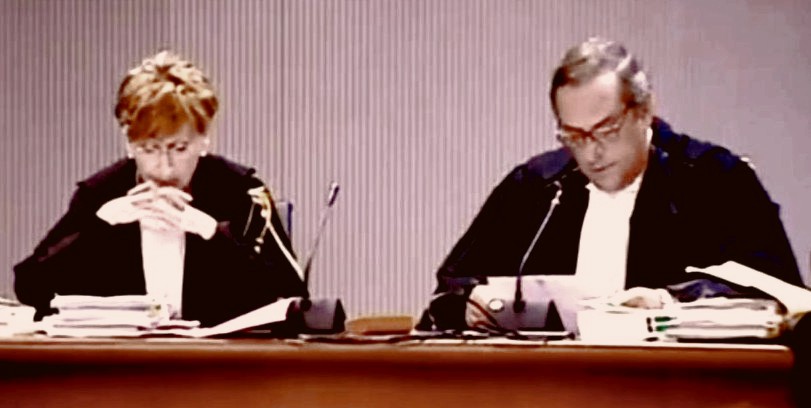
[Above the two co-judges with lead judge Allessandro Nencini reading the case history]
Explanation
The previous post listed what has already been agreed to by the court to guide the appeal. This report which only became available later describes what had been the prosecution and defense requests.
Translation From The Umbria24 website
Meredith, war of requests in the first hearing of the 2nd Appeal
The court has order a new test on the I trace and on the hearing of the witness Luciano Aviello. Rejected all other requests
By Francesca Marruco
After a little over 2 hours in counsel chambers the Florence Court of Appeals has decided to order a new test on the trace evidence of the knife seized in Raffaele Solecitto’s apartment, the weapon presumed to have been used in the murder.
The Court has also decided to hear the witness Luciano Aviello but rejected all the other requests for renewal of investigations presented by the defense. The Court resumes on Friday with Aviello and the assignment of the task of the new genetic analysis to the Carabinieri del Ris of Rome.
[The appeal] this morning in the maxi courtroom no. 32 of the Florence Justice Courthouse, commenced the new appeal for the murder of Meredith Kercher, after the annulment of the acquittal by the Supreme Court.
Present in the courtroom was only Patrick Lumumba. Absent, as expected, were the two appellants, Amanda Knox and Raffaele Sollecito.
- 9:00 Francesco Sollecito, father of Raffaele, says he is tranquil about the outcome of the new trial. Responding to journalists, he specified “The statement of the Supreme Court is compromised by errors committed because the judges did not have full access to all of the proceedings, as they themselves indicated.”
- 9:45 The defense of Knox and Sollecito have asked for the exclusion of the Patrick Lumumba (civil) party because the conviction of Amanda for calunnia has already been passed into final sentence.
This request was opposed by the General Prosecutor Alessandro Crini, and the lawyer of Lumumba. For them the plaintiff’s civil right is legitimate, as the Supreme Court has asked this court to re-evaluate the penalty in light of the finalized sentence of Knox.
The Court retired to counsel chambers to decide, announcing it wanted to decide today on any reopening of the investigation.
- 10:15 The court rejects the request of the defense of Knox and Sollecitto to exclude the civil party Patrick Lumumba, because the Court specifies that, among other things, the offense was not assessed in totality by the trial court.
- 10.50 The President of the Court of Appeals, Allessandro Nencini, is initiating his introductory report, starting from the day of Meredith’s homicide. The judge travels trough the most important passages of the three Courts. Speaking of the trace, secured by the consultants of the second [Hellman] Court, on the knife (considered the weapon of the crime by the first Court) President Nencini said: “It is necessary to underline that the independent consultants had found another trace; but it was not analyzed”.
- 11:15 The President of the Court, Judge Nencini, at the end of the introductory report, said: ” This is an appeal for matters of undeniable seriousness beyond the media spectacularization. Thus the Court is willing to give all possible space for debate to all of the parties, because originally there was a solid verdict, and the actions on which we proceed are of undeniable seriousness”
- 11.25 Raffaele Sollecito defense lawyer Giulia Buongiorno was the first to take the floor.
]Bongiorno:] Sollecito’s defense does not ignore the motivations of Cassazione, and we are in favor of any kind of verification that the Court will order, with the following caveats. This proceeding has always been based on two types of evidence, the testimonial and the technical. We request that during this proceeding, which we hope to be the last one, that the Court during the next hearings will concentrate only on the truly reliable evidences, putting aside those that are nullified by media conjecture.
Many witness have said things because they have read them or heard them. The proceeding was reopened, but not to collect this type of guesswork. We do not want to inflate this proceeding with new conjectures. We request to examine in depth the crime observed, as emphasized by Cassazione. In the crime scene room there are copious traces of two of the four claimed present persons, the victim and Rudy Guede who admitted to having been there, and none of the two appelants except on the hook of the victim’s bra.
When the Prosecutor asserts that there are no traces because Amanda and Raffaele cleaned them, we think that this is impossible. For this reason we request to have a evaluation done in order to verify if it is possible to clean selectively… A Cassazione mistake was that it didn’t notice the entry into the crime scene room before the bra hook was found, so we request the acquisition of two reports [on that].
We want to understand if in a sealed place it is possible to get firm evidence even after the admission by the police of other searches. We do not request to simply take the hook and to say that it is contaminated, we want to know if in that environment it was possible to collect some genuine evidence, because at the crime scene there were not ten traces of Raffaele but only that one”.
A subordinate request by Giulia Buongiorno is that experts, new experts or the ones at the Hellman appeal, will read the electropherograms. Buongiorno requests the analysis of both of Meredith Kercher’s cell phones that she consider the “black box” of the crime and that they “were never analyzed deep enough by the Corte d’Assise di Perugia” The defense requests also analysis of the presumed sperm trace on Meredith’s pillowcase.
- 12.15 Amanda Knox defense lawyer Carlo Della Vedova takes the floor and raises right away an exception to the judge’s stipulations. “Are we today able to judge on matters that happened six years ago? Can a person be under proceeding for life? Are we sure that Amanda Knox is an accused like all the others? Is it right, the indefinite delay of this proceeding? For all of this I insist that the Court evaluate the constitutionality.”
- 13.00 The Kercher family’s lawyer produced a letter written by the family members of Meredith that read “We are confident that the evidences will be reexamined and all the requests of more evidences will be granted, in a way that all the unanswered questions will be clarified and that the Court can decide on a future way of action in this tragic case. The past six years have been the most difficult of our lives and we want to find an end and remember Meredith as the girl that she really was rather than remember the horror associated with her”.
-14.00 The General Prosecutor Alessandro Crini says he is against the request of the defense to hear anew from some witnesses, including Rudy Hermann Guede. The same argument Crini voiced for the majority of the requests of the opening introduction presented by the defense. In conclusion, he asked for the the addition of the evaluation of the “I” trace, isolated by the independent experts, but never analyzed because they claimed it was believed to be Low Copy Number. Furthermore the prosecutor asks that the witness Aviello be reheard.
-15:00 The lawyers of the civil part that represent the Kercher family support the request of the General Prosecutor Crini, and opposed the requests of the defense. The lawyer Francesco Maresca said he believes that the defense attempts to frame with a new “dress” evidence that is strong, resistant, and robust, from the findings of the trial court, and that were minimized by the first appeal court. For example, the witness Capezzali.
Also there are newly framed certain requests that are obsolete, that have already been actioned. Like that of the selective cleaning. In the bathroom next to the room of the crime, there were many mixed traces of DNA of Amanda and the blood of Meredith. And the genetic profile of Sollecito, besides on the bra hook, was present only mixed with that of Amanda on a cigarette butt, then how did it migrate, only that one, from the cigarette butt to the bra hook?
- 15:10 The defense of Raffaele Sollecito maintains the request to analyze the “I” trace, but opposes hearing from the witness Luciano Aviello. Buongiorno also pointed out that it is not true that the independent experts of the second court decided automatically to not analyze certain traces, but did so in the presence of the prosecution experts Stefanoni and Novelli and those of the defense. Carlo Dalla Vedova, for the Knox defense, said that Avelio should be heard only to demonstrate that the police uses him two different ways. Like when Avelio said he knew where the crime weapon was.
- 15.30 The Court retired in council chamber and announced that will not come out before 17.30
Conclusion
Thereafter the court convened again and the decisions were as outlined in our post below this one. Almost all of what the defense had argued for - each of them a stretch if you know the full circumstances - was denied.
And the two main requests from the prosecution - that Aviello be put back on the stand, and the large knife be retested - were accepted. Ourcomes of these may or may not add to the strength of the prosecution’s case, but seem to offer no prospects of joy for the defenses.
Friday, September 27, 2013
Questions For Sollecito: Why So Many Contradictory Explanations Of How DNA Got On The Knife?
Posted by SomeAlibi
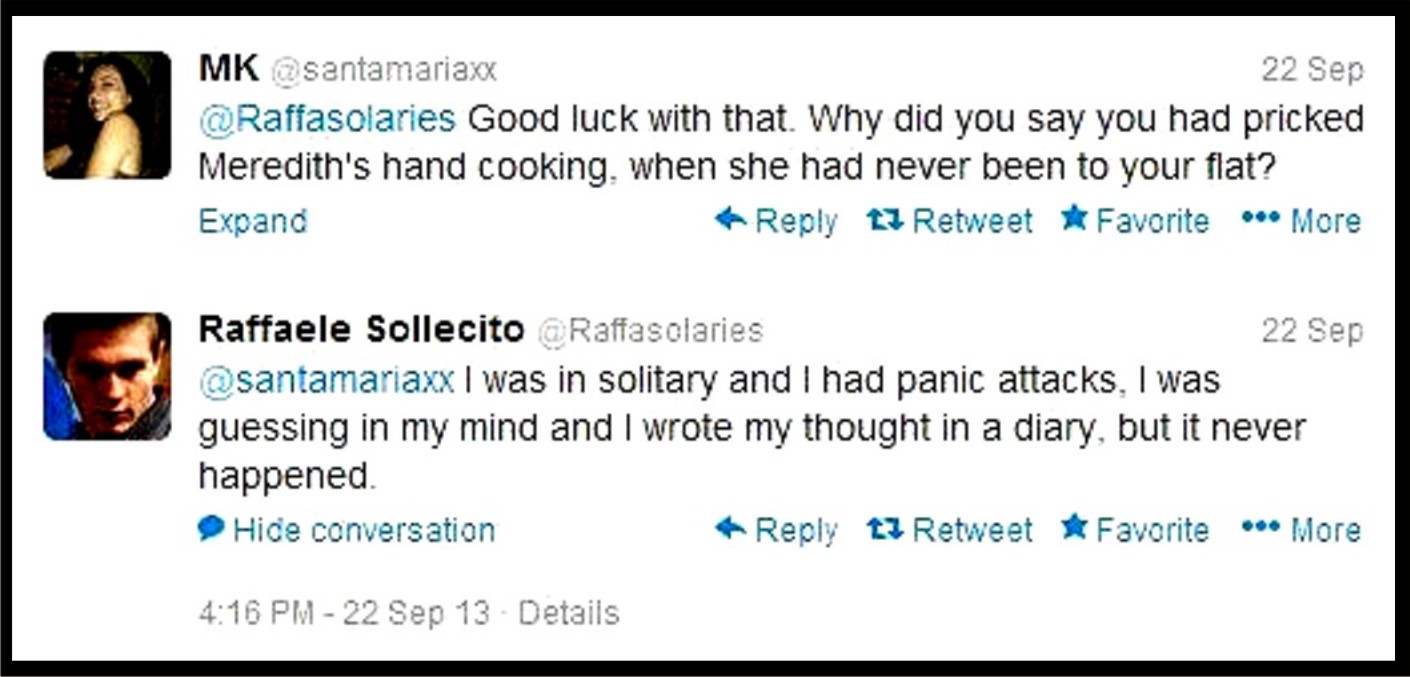
It is no secret (except seemingly to him) that Sollecito’s book and web postings will once again land him in court.
This trial will be separate from the main appeal though the prosecution office will be the same. It will be for alleged contempt of the court in serially mis-stating the evidence and accusing many officials of crimes in an attempt to get public opinion to lean heavily on the courts.
The Amanda Knox brigade has been trying that too, and look at how well that is working out!
Here is one seemingly perfect example of how Sollecito (finally responding to the pressures and pleas of his discombobulated lawyers?) may be trying to wind things back. You will recall that news of the discovery of a large knife in his kitchen drawer with Meredith’s DNA on it was related to Sollecito while he was in his prison cell, just over two weeks after the murder.
As much as the news initially panicked him, shortly thereafter on November 18th, 2007, he seemed relieved to have realised how Meredith’s DNA could have come to be on his kitchen knife after a session of, in his written words, “thinking and remembering”. He wrote in his diary:
The fact that there is Meredithʹs DNA on the kitchen knife is because on one occasion, while we were cooking together, I, while moving around at home {and} handling the knife, pricked her hand, and I apologized at once but she was not hurt {lei non si era fatta niente}. So the only real explanation for that kitchen knife is this one.
And that was it: Raffaele had “fortunately” remembered how he had “pricked” Meredith’s hand and that explained the DNA. He remembered it in precise detail - thank heavens for that!
The problem for Raffaele was that he didn’t know at this stage that the DNA was in a microscopic groove on the blade and not on the tip. The story made no sense. Worse, he was also flatly contradicted by the flatmates, the friends and even Amanda: he had never been cooking with Meredith and his story was therefore impossible as well as implausible. And since he was a murder suspect, the memories and all their specificity which would have given him an alibi for the DNA, became highly suspicious.
Unfortunately, Raffaele chose to remain silent thereafter and never testified, as was his right, at his trials.
Subsequently there were many months of Team Knox-Sollecito denying that Raffaele meant Meredith, in contradiction of all plain logic when reading the simple words in his diary. No, said the online apologists, in fact he meant Amanda’s hand and in some way he had thought that maybe Meredith’s DNA had been on Amanda and could have transferred. It wasn’t his fault that his theory was wrong, it was just an honest memory of being with Amanda and nothing suspicious at all.
On Twitter on September 22nd, Raffaele decided, probably unwittingly as is his wont, to blow that theory up. He was asked about the diary entry by Twitter user MK @santamariaxx and responded thus:
He replied as in the image above.
So, he didn’t really mean Amanda at all (thank-you for all the wasted hours of excuse making for Raffaele to those protagonists of that particular theory), but now we learn it was a false memory about Meredith that never happened.
But let’s unpick this because it’s far from a single mis-remembered sentence or action. This was a contemporaneous diary entry made barely two or three weeks after such a cooking event could have happened and it was a multi-faceted event with multiple actions. He was clear and precise about what happened in detail. Now, he is quite clear the whole thing never happened:
- 1. He said he was cooking together with Meredith - but that never happened
2. He recalled himself “moving about” during the cooking session - but that never happened
3. He remembered the location “at home” - but was never there in this context
4. He remembered putting a knife that he was holding into / onto Meredith’s hand - but that never happened
5. He remembered actively apologizing to Meredith for that clumsy act - but that never happened
6. He remembered the act of them examining Meredith’s hand and mutually discovering that she had not been hurt - but that never happened
7. He remembered that this was the real explanation of the kitchen knife - but it never happened
Sollecito was on his own in a cell, not under interrogation, and spending time “thinking and remembering” on November 18th. What he remembered, in detail, was a multi-part sequence of events with a girl who had been murdered barely two weeks before. He remembered the minutiae of what happened and its sequence when he believed he needed to provide an alibi for the identification of the DNA on his knife.
None of Amanda Knox’s vagueness about these memories - they were particular and specific in the finest detail. So fine and specific that when he was caught out that this could not have happened, those details looked highly like someone seeking to convince precisely because of the particularity of the details. It was in the time-honoured form: “no, no - it definitely happened, because I specifically remember”..... 7 distinct and separate memories and the sequence in which they occured.
But all those things never happened according to Raffaele Sollecito in 2013.
Knox and Sollecito have never stopped the self-serving lies and flat contradictions of themselves. Not now, even after all this time, even after one them is permanently stained as, at a minimum, a convicted liar who criminally tried to frame a man for murder. Sollecito, “not hiding” in his secret location, can’t stop either. Little good it will do either of them. Finally, justice is coming and the lies will be at end. I’d almost feel sorry for him, if he wasn’t then and remains now, an inveterate liar without the honour to face justice in the country of his birth.
Monday, August 05, 2013
A New DNA Analysis Strongly Implicating Sollecito Seems to Have The Defense Forces Rattled
Posted by The Machine
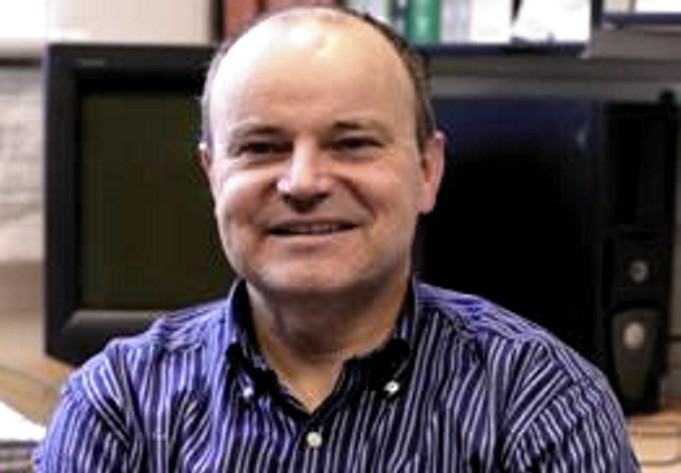 F
F
[Above: DNA professional Professor David Balding; at bottom, DNA amateurs Barras and Halkides]
The Supreme Court has already shown strong disdain for the myriad dirty tricks of the defense forces, and legal action is building against them (see our post next week).
That the defense forces in this context attempt to put out even more misleading information seems a sure sign that their backs are to the wall, and that they will risk anything to again tilt the playing field.
Colin Barras
“Software says Amanda Knox’s DNA wasn’t at crime scene” This highly misleading header appeared above an article by Colin Barras on the New Scientist website last month.
It should be pointed out that Colin Barras isn’t a DNA expert. He has never been involved in a forensic investigation. He has never provided expert testimony in a court case. He is simply a freelance British science writer with degrees in geology, palaeobiology and palaentology - the palaentology of Jurassic sea urchins.
Barras explains in his article that Professor David Balding, a Professor of Statistical Genetics at University College London, has developed new software for interpreting Low Template DNA evidence.
This is true. However, Barras then goes on to make the following claim:
Using the software on data from Knox’s trial suggests that it was very unlikely that her DNA was at the crime scene.
In fact Professor Balding and his software suggested nothing of the sort. Professor Balding was referring specifically to an incomplete DNA profile on Meredith Kercher’s bra clasp which has never been at much issue.
He did not refer to all the other DNA evidence that was collected at the crime scene and presented as evidence in court.
It’s important to clarify what this crime scene actually is, because the defense forces of Amanda Knox and Raffaele Sollecito constantly move the goalposts in relation to this case depending on who they are talking about.
When they talk about the evidence against Knox and Sollecito, their version of the crime scene is strictly limited to Meredith’s room. When they discuss the evidence against Guede, their version of the crime scene includes other rooms in the cottage i.e. the other bathroom and the hallway. And when they discuss the collection of the DNA evidence, their version of the crime scene suddenly includes the flat downstairs, even though no crime was committed there.
According to Wikipedia “A crime scene is a location where a crime took place (or another location where evidence of the crime may be found), and comprises the area from which most of the physical evidence is retrieved by law enforcement personnel, crime scene investigators (CSIs) or in rare circumstances, forensic scientists.”
The Scientific Police from Rome and the Forensic Police from Perugia clearly regarded most of the cottage as a crime scene. The Forensic Police from Perugia catalogued potential evidence by placing letters and numbers in different rooms in the cottage. (The Massei report, p200).
The Scientific Police then collected DNA and forensic evidence from Meredith’s room, Amanda Knox’s room, the hallway, the kitchen, the blood-spattered bathroom, the other bathroom which was used by Filomena and Laura and Filomena’s room where the break-in was allegedly staged. That’s a total of seven rooms.
And the Scientific Police didn’t actually claim at the trial that the incomplete profile on the bra clasp belonged to Amanda Knox. It was Sollecito’s forensic expert Professor Vinci who claimed that Knox’s DNA was on Meredith’s bra. His findings were presented in court at Rudy Guede’s fast-track trial in 2008.
So Colin Barras has used a straw-man argument. He has completely ignored the six pieces of DNA evidence that place Amanda Knox at the crime scene on the night of the murder.
According to the prosecution’s experts, Amanda Knox’s blood was found mingled with Meredith’s blood in three places in the bathroom: on the ledge of the basin, on the bidet, and on a box of Q Tips cotton swabs.
Knox’s DNA and Meredith’s DNA was also found mixed together in a bare bloody footprint which was revealed by Luminol in the hallway and a mixture of Knox’s DNA and Meredith’s blood was also found on the floor in Filomena’s room.
Amanda Knox’s DNA was found on the handle of Sollecito’s kitchen knife and a number of forensic experts - Dr. Patrizia Stefanoni, Dr. Renato Biondo, Professor Giuesppe Novelli, Professor Francesca Torricelli, Luciano Garofano, Greg Hampikian and Elizabeth Johnson - have all confirmed that Meredith’s DNA was on the blade.
Dr Stefanoni analysed the traces on the knife six days after last handling Meredith’s DNA. This means that contamination couldn’t have occurred in the laboratory. Meredith had never been to Sollecito’s apartment, so contamination away from the laboratory was impossible.
The knife is still in evidence and remains compelling evidence against Knox and Sollecito.
Ominously for Knox and Sollecito, the Supreme Court explained how DNA evidence should be assessed in court i.e. contamination must be proven with certainty not supposition.
The burden of proof is on the person who asserts contamination, not the person who denies it.
In other words, if the defence lawyers claim the DNA evidence was contaminated, they must describe the specific place and time where it could have plausibly occurred.
Nobody has ever proved that the bra clasp and knife evidence were contaminated and it’s difficult to see how the defence lawyers’s experts are going to do this at the new appeal.
Chris Halkides
Chris Halkides is one of Amanda Knox’s most effusive supporters. He has pontificated extensively about the case on his blog View from Wilimington and on other Internet websites.
On 30 July, he was finally prompted to post an interview with Professor Balding done some months previously. I suspect Halkides had been very keen to interview Professor Balding after reading Colin Barras’ article on the New Scientist website; but was holding back on posting it because it went against his own claims.
Indeed, his interview has turned out to be quite a slap in the face for the Friends of Amanda and Colin Barras, because Professor Balding categorically described the DNA evidence against Sollecito to Halkidis as “strong”.
It’s worth summarising Professor Balding’s impressive academic record which for this case is topnotch, perhaps the best .
He is currently the Chair of Statistical Genetics at University College in London. He has a first-class honours degree and a PhD in Mathematics. And he has written many journal articles and co-authored a number of books on a range of topics.
This is apparently the whole of Chris Halkides’ interview with Professor Balding:
TUESDAY, JULY 30, 2013
An interview with David Balding
Part 36 in the Knox/Sollecito case
Professor David Balding recently published an analysis of the bra clasp DNA. It may be helpful to explain some terms found in this article. John Butler (Fundamentals of Forensic DNA Typing) defines the likelihood ratio (LR) as “The ratio of the probabilities of the same event under different hypotheses, and he explains that the prosecution’s hypothesis is usually the numerator, and the defense’s hypothesis is usually the denominator. A ban is a unit of expressing the weight of evidence (WoE). This scale is logarithmic; a likelihood ratio of three bans is equal to one thousand. Some months ago Dr. Balding was kind enough to answer some of my questions about this work.
Does Raffaele Sollecito¹s DNA fall into the category of low template DNA, and if so, should two separate amplifications have been run?
There’s no strict definition of “low-template” but broadly yes the peaks associated with Sollecito are low (but not those associated with Kercher, they are high). Conti-Vecchiotti discuss a threshold of 50 rfu below which a peak should not be relied on; in the UK, that threshold was used in the past but nowadays as techniques have improved the threshold is often lower, 25 or 30.
However that doesn’t matter here as all the peaks associated with Sollecito are well above 50: there is a 65, a 70 and a 98, all the 26 other peaks are above 100. So it is not extremely low template - many low-template cases are successfully prosecuted in the UK even when some peaks fall below the threshold and so are discounted. In this case all the peaks associated with Sollecito seem clear and distinct so I think there can be no concern about the quality of the result as far as it concerns him or Kercher.
Replication is generally a good thing and is nowadays done in most cases in my experience, but not all - one problem is that replication splits the sample and so can increase the chance of not getting a usable result. But although replication is desirable it is not essential. (In a sense there already is replication, because each of the 15 loci is an independent test.)
This is all a matter of weight of evidence, which Conti-Vecchiotti paid no attention to: if you measure the weight of evidence properly, that accounts for the extra assurance that comes from replication and gives a stronger result (or conversely gives a weaker result if there is not replication). But because Sollecito is fully represented in the stain at 15 loci (we still only use 10 in the UK, so 15 is a lot), the evidence against him is strong even allowing for the additional uncertainty due to non-replication.
Are there contributors other than Raffaele Sollecito and Meredith Kercher to the autosomal profiles? If so, how does the presence of this additional DNA affect the bra clasp as evidence?
Yes, Conti-Vecchiotti identified a further 12 above-threshold peaks at alleles that could not have come from Sollecito or Kercher. They correctly criticised the scientific police for ignoring these: many do appear to be stutter peaks which are usually ignored, but 4 are not and definitely indicate DNA from another individual. The extra peaks are all low, so the extra individuals contributed very little DNA. That kind of extraneous DNA is routine in low-template work: our environment is covered with DNA from breath and touch, including a lot of fragmentary DNA from degraded cells that can show up in low-template analyses.
There is virtually no crime sample that doesn’t have some environmental DNA on it, from individuals not directly involved in the crime. This does create additional uncertainty in the analysis because of the extra ambiguity about the true profile of the contributor of interest, but as long as it is correctly allowed for in the analysis there is no problem - it is completely routine.
Are there contributors to the Y-STR profile other than Raffaele Sollecito? If so, how does the presence of this DNA affect our interpretation of the bra clasp as evidence?
I haven’t looked closely at the Y evidence - there seems no need for it because the autosomal evidence is overwhelming for the presence of DNA from Sollecito. But from a look at Conti-Vecchiotti, it seems to back up the conclusion from the autosomal profiles: Sollecito’s alleles are all represented and these generate the highest peaks, but there are some low peaks not attributable to him; so at least one of the additional contributors of low-level DNA to the sample was male.
The bra clasp was collected about 47 days after the murder, and it was found in a different location from where it was initially observed. In the interim many people entered the cottage and items from her room were removed. Are these concerns sufficient for the clasp to be excluded as evidence?
The only worry would be if somehow DNA from Sollecito was brought into the room and deposited on item 165B. I don’t know enough about what happened to say if that was likely but I’d guess that people walking in and out of the room etc would be unlikely to do that.
The clasp was collected with gloves that were not clean, not with disposable tweezers (videos here and here). The glove was handled by more than one person. Are these concerns sufficient for the clasp to be excluded as evidence? If not, should the clasp be given less weight as evidence because of them?
Same comment - the only concern is if any of this could have transferred DNA from Sollecito onto item 165B.
Would you care to comment on the storage of the clasp after the forensic police tested it?
I know nothing about it.
Did you analyze the electronic data files? Did you examine the laboratory¹s own protocols and machine logs?
I have only seen the epgs for the autosomal DNA profiles of 165B. There is an unclear version of them in the Conti-Vecchiotti report, but Prof Vecchiotti kindly provided me with a clean set.
Did you examine the negative controls?
No
Fellow main poster Stilicho highlighted the most important conclusions from this interview on the PMF Forum where the quality of the DNA discussion is very informed.
The interview contains a few things that have been vigorously denied by the FOA:
The 50 RFU level is not sacred or inviolable.
It is improbable that Sollecito’s DNA got there by secondary transfer or by contamination.
The likelihood that the DNA on the bra clasp is Sollecito’s DNA is “overwhelming”.
...the interview doesn’t contain anything not already known to both sides but it contains several key elements that are not accepted by both sides.
Chris Halkides asked two-part leading questions and didn’t get the answers that would be needed to continue to falsely assert that Sollecito’s DNA is not abundant on the clasp or that, if it was there, it likely got there by some other route.
All the other inferences about environmental contamination are irrelevant to Balding’s main point: it is Sollecito’s DNA on that clasp and it didn’t get there by accident.
Final Thoughts
Some credit must go to Chris Halkides for finally posting the interview with Professor Balding even though it categorically said the DNA evidence against Sollecito is strong. I’m not sure he’ll be invited to any FOA events in the future.
Shame though on Colin Barras, for writing such a misleading article, and for using a straw man argument to highly misrepresent the DNA evidence against Amanda Knox which was then deliberately fed to the Italian media.
He completely ignored the six pieces of evidence that place her at the crime scene on the night of the murder. He also completely ignored the most important of Professor Balding’s findings. ie that the DNA evidence against Sollecito is strong.
This finding implicates Knox and places her at the crime scene when Meredith was killed, and makes a mockery of Barras’s headline that suggested otherwise.
[Below: the wannabe crime-scene DNA experts Colin Barras, left, and Chris Halkides, right]
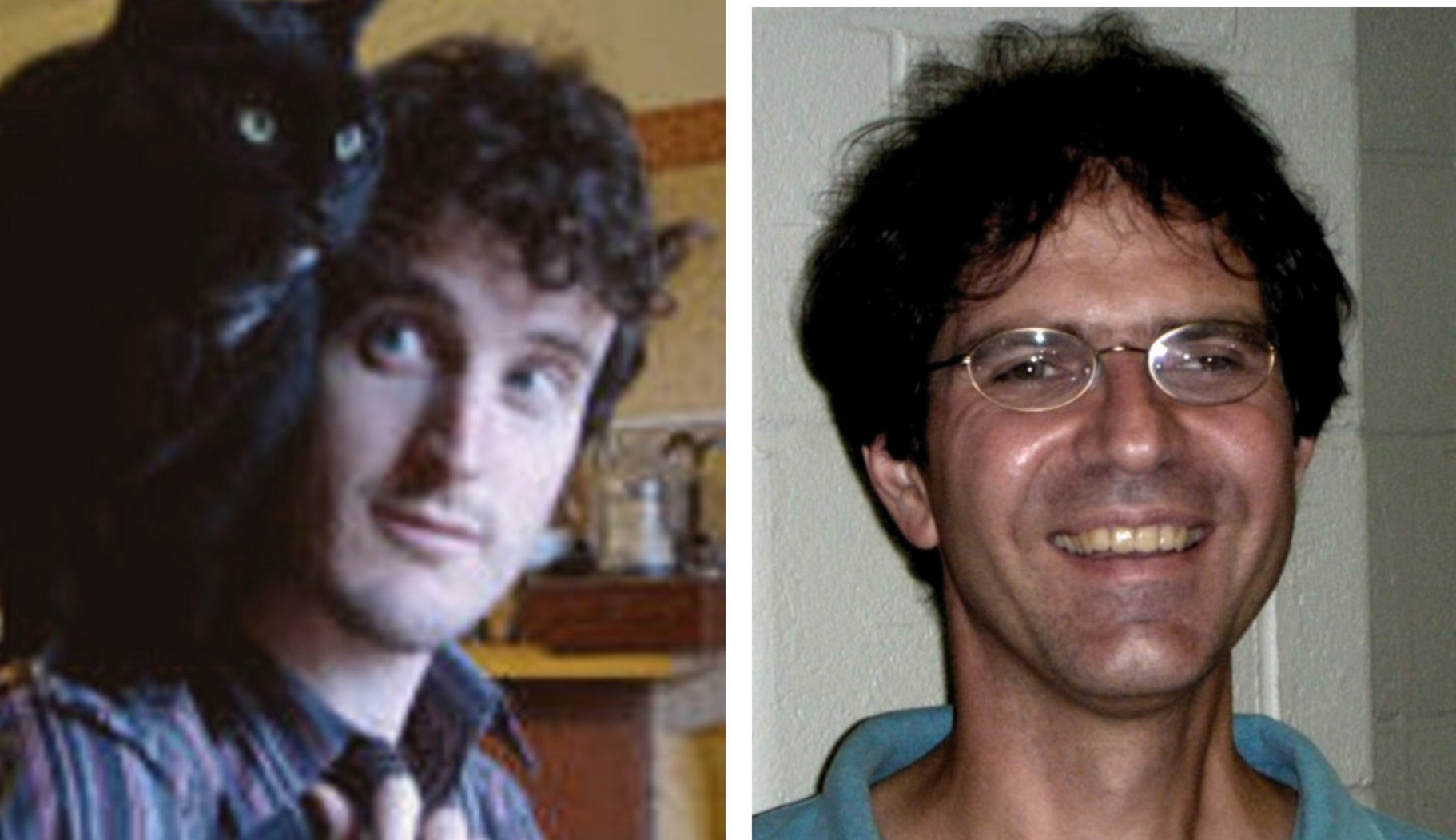
Wednesday, July 24, 2013
How The Clean-Up And The Locked Door Contribute To The Very Strong Case For Guilt
Posted by James Raper
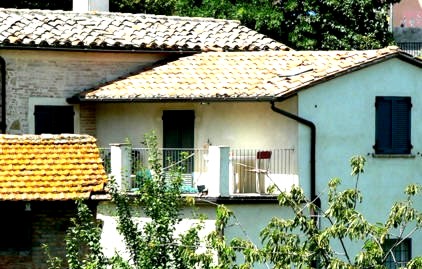
On the 30th September the appeals of Amanda Knox and Raffele Sollecito against the convictions they received at the first instance trial will resume, this time in Florence.
This follows the annulment by the Supreme Court of the acquittal verdicts rendered by the Appeal Court presided over by Judge Pratillo Hellmann. There is one conviction not under appeal. This is Knox’s conviction for calunnia, which is now definite.
They are therefore both currently convicted of murder and sexual assault, and a number of lesser charges, amongst which there is the simulation of a burglary “to ensure impunity for themselves from the felonies of murder and sexual assault, attempting to attribute the responsibility for them to persons unknown who penetrated the apartment to this end”.
There is one activity, for which there is evidence, with which they were not charged (perhaps either because it was redundant or not a criminal offence) though this was likewise to ensure impunity for themselves.
This is the partial clean up at the cottage and it is this with which I intend to deal. I want to highlight salient observations which have been under discussion here and elsewhere and some of which may be well known to readers, but perhaps some not, or have been forgotten about. Once again, in many cases, I am merely a conduit for the observations of others, not least the first instance trial judge Giancarlo Massei.
So let”˜s consider the observations and in doing so we can also throw some more light on the lone wolf theory.
1. Take a look at the bloody footprint
This is, of course, the bloody footprint on the bathmat in the small bathroom right next to Meredith’s room.
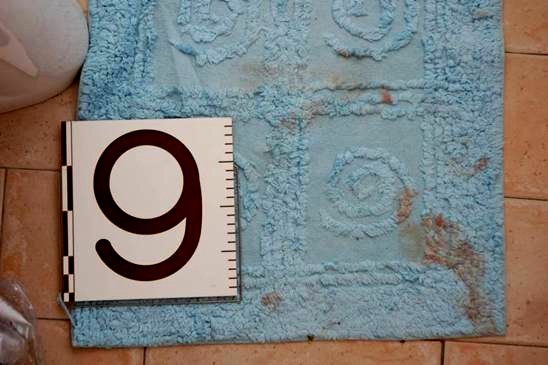
The heel of the right foot, if it had blood on it, is missing from where it should be on the tiled floor. It is difficult to imagine, given that the imprint of the foot on the mat is contiguous with the edge of the mat, that there was not at least some blood on the remainder of the foot such that there must have been at least some blood deposited on the floor.
Just as difficult to imagine that casual shuffling about on the bathmat would have removed the blood so as to render it “invisible” to the use of luminol.
Of equal relevance is that there were no connecting bloody footprints. Why not?
The defences have an improbable theory - that Guede, despite his homicidal rage, was smart enough to hop about on his left foot with a clean shoe on, and the other bare but covered in blood, and that having by this means entered the bathroom and washed his bloody right foot, disastrously leaving his (supposed) imprint there in the process, he then returned to Meredith’s bedroom inadvertently standing in blood with his left shoe and leaving with a trail of bloody left shoe prints - in which case the exercise of washing his foot was entirely in vain, on two counts, after all that careful hopping around.
Neither is it entirely clear why his right shoe came off in the first place.
It is far more probable that the inevitable bloody prints were deliberately and carefully removed. The reason for doing this was not just to conceal who would have made them (the print on the bathmat was, after all, left in situ) but, from a visual perspective, to conceal any blood that might be noticeable and alarming to anyone approaching Meredith’s room. Guede’s bloody shoeprints in the corridor were visible but only on close inspection.
2. Take a look at the bathroom door
Specifically the internal (hinge) side of the bathroom door. Take a look at this photograph.
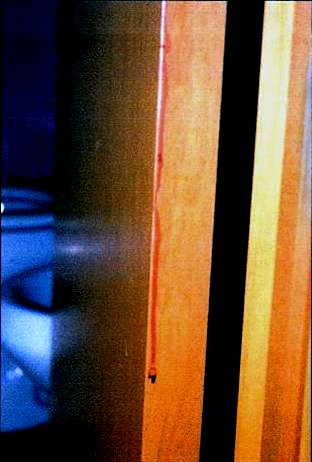
We see a long streak of dried blood. Clearly the blood has flowed some distance under the influence of gravity and we can see that it looks slightly diluted, with red corpuscles gathering towards the tip of the streak. A drip of that size does not appear from nowhere.
Indeed it is difficult to imagine how the blood got there unless it was part of a larger area of blood which most likely was on the face of the door and which was swiped to the right and over the edge of the face of the door. The cloth or towel used to do this was wet accounting for the slight dilution and length of the streak.
3. Take a look at Meredith’s door
It is interesting, is it not, that there is blood on the inside but not on the outside? The outside:
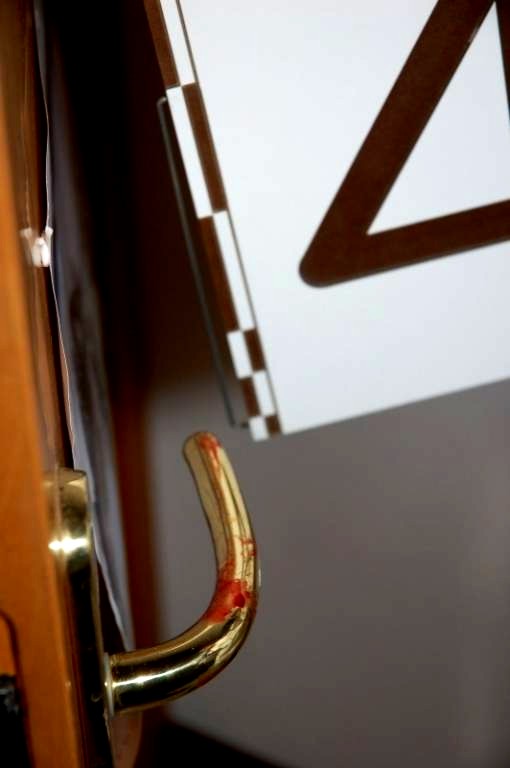
It is difficult to see how and why Guede touched the inside handle with a bloody hand (was it shut and if so, why?) and then closed the door to lock it without leaving a trace on the outside face of the door. Possibly he might have changed hands. The answer might also be that he visited the bathroom to wash his hand as well as his foot, save that none of his DNA was recovered from the spots and streaks of diluted blood in the washbasin, whereas Knox’s DNA was. All the more surprising given that Guede shed his DNA in Meredith’s room.
We see some blood on the edge of the door which again might be the remnant of a trace on the outside face.
4. Take a look at Amanda Knox’s lamp.
This was found inside Meredith’s room behind the door. Meredith also had a similar lamp which was resting on it’s base on the floor by her bedside table.
The presence and location of Knox’s lamp is obviously suspicious. Had Meredith borrowed Amanda’s lamp because her own was not working, then it would not have been in the position it was found but on or more likely knocked over and lying beside the bedside table since the violence appears to have been concentrated in that area of the room.
Had Meredith’s lamp been on the bedside table then likewise it too would most likely have been knocked over in her life and death struggle with her sole assailant (there are blood streaks on the wall just above) and it would not have ended up sitting upright on it’s base.
Both lamps were probably used to check the floor of Meredith’s room after the event and Knox’s lamp was probably sitting upright until it was knocked over by the door being forced open.
This is Meredith’s lamp by the bedside table.
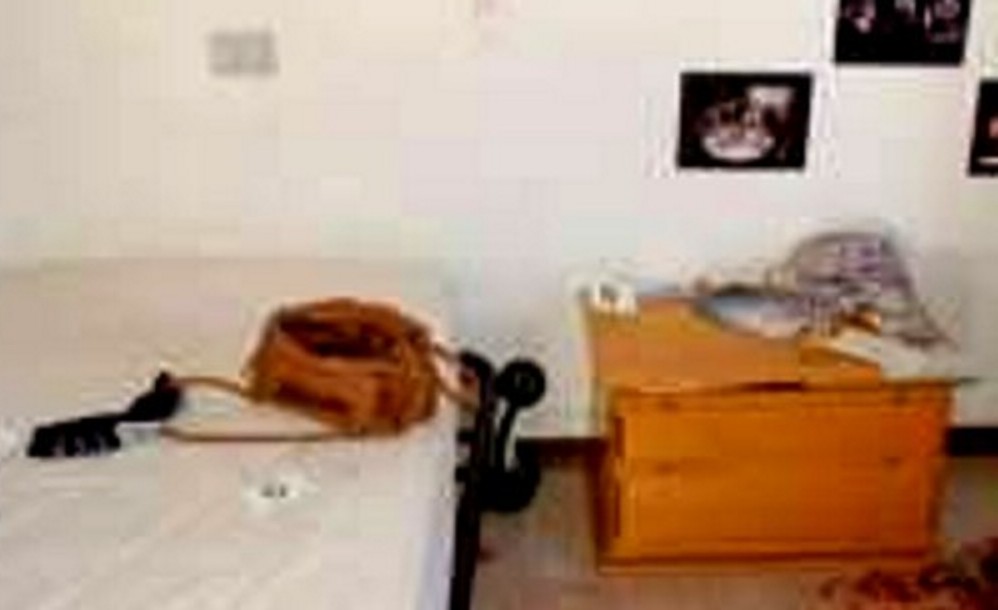
And this is Knox’s lamp by the foot of the bed.
5. Take a look at what luminol revealed
We can state with confidence that luminol (extremely sensitive to and typically used to identify blood that has been wiped or washed away) discovered :-
(a) three bare footprint attributable to Knox, one in her bedroom and two in the corridor, and
(b) two instances of the mixed DNA of Meredith and Knox, one in Filomena’s bedroom and one in the corridor.
(c) a footprint attributed to Sollecito in the corridor.
I have covered a number of elements strongly suggesting that there was at least a partial clean up, not of “invisible DNA” as the Groupies like to mock, but of what would have probably in some cases have been noticeable deposits of blood that would have attracted the eye of anyone entering the cottage and which would certainly have alarmed the observer as being difficult to explain.
Spots of and footprints in blood, not just in the bathroom but outside it, a locked bedroom door with blood on it, and a bathroom door with blood on it’s face.
We can include Knox as one such observer given her e-mail account of having allegedly stopped by the cottage to have a shower and collect some clothing before the discovery of the body. Such physical evidence - had it not been removed - would not have sat easy with that account, however dizzy and naïve Knox presents herself. One can envisage Knox thinking “sorted” - that her story would now work perfectly.
Even so, there were elements that were overlooked, such as Knox’s blood on the washbasin faucet and blood generally in the small bathroom, but a door can be closed and at least these were elements amenable to some form of explanation from her perspective, whether or not convincing, as occurred in the e-mail.
Incidentally in addition to the mixed traces in the small bathroom, Meredith’s blood was found on the light switch and a cotton bud box. I have a hard time imagining what Guede would have wanted with the cotton bud box, less so Amanda given her blood on the faucet, ear piercings and a scratch on her throat. Knox, when asked during her trial, could not recall having switched on the light during her alleged visit to the cottage.
6. Take a look at the items on Knox’s bed
Massei concluded that it was likely that it was Knox who carried out the clean up, which if correct might explain why it was not central to her thinking to dispose of the bathmat with Sollecito’s bloody footprint on it!
Knox was seen by Quintavalle at his store at 7.45 am on the 2nd November, thereby destroying her alibi. He described her as pale faced, exhausted looking, with pale blue eyes. He also added, and he would not have known this from photographs in the newspapers, that she was wearing blue jeans, a grey coat and a scarf, with a hat or cap of some sort.
We can see from the crime scene picture of Knox’s bedroom below, that such items (minus hat or cap) appear to be lying on her bed.
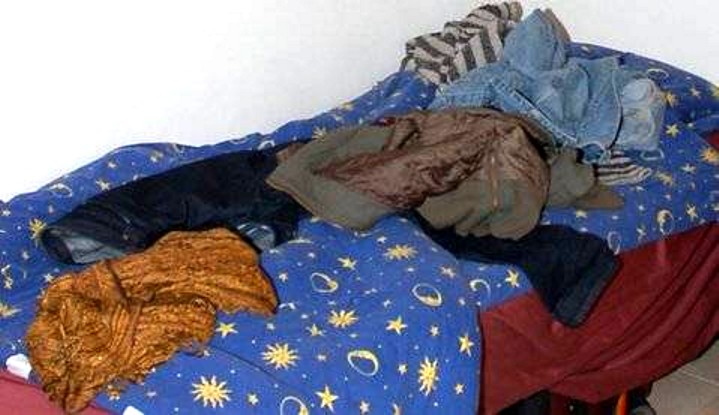
Sollecito did not accompany Knox to the store but this would be because he was known to Quintavalle whereas he was unfamiliar with her. He may however have accompanied Knox to the cottage and/or have acted as look out for her when she was there.
7. Some conclusions
I have included “The locked room” in the title because of a poster’s observation regarding Guede’s bloody left shoeprints exiting Meredith’s room. There is the simple observation that these footprints are going one way only and not towards the small bathroom. But they do not even turn to face Meredith’s door, and again hard to imagine that this could be so if it was Guede who locked her door!
We can rule out Guede as having been involved in any aspect of the clean up precisely because of that trail of footprints and other evidence of his presence left behind.
Now that the travesty of the Hellmann acquittals has been truly exposed Knox and Sollecito face an impossible uphill task.
The clean up and the locked door are just two of many elements in this case which combine together and corroborate each other in a manner that enables us to see the truth beyond a reasonable doubt.
Saturday, June 08, 2013
Questions For Sollecito: Can You Realistically Account For The Bathroom Mat Evidence?
Posted by Our Main Posters
1. Your Attempted Bath Mat Hoax
Let us start this series of questions to you with the bloody bathmat footprint
Specifically how you characterized it at different points in your book as part of your attempted proof that Guede acting alone did the crime.
Here is the full extent of your hoax “proving” that that print was actually from Rudy Guede’s foot.
(a) [Page X11] The intruder was quickly identified as Rudy Guede, an African immigrant living in Perugia with a history of break-ins and petty crimes. His DNA was found all over Meredith’s room, and footprints made in her blood were found to match his shoes. Everything at the crime scene pointed to a lone assailant, and a single weapon. Guede repeatedly broke into houses by throwing a rock through a window, as happened here
(b) [page 23] Amanda went ahead with her shower, only to notice a small bloodstain on one of the washbasin taps. It looked like menstrual blood. Was Meredith, who shared the bathroom with her, having some sort of problem? It was unlike her to leave things less than immaculate. Maybe she’d run out to a pharmacy. Then again, it was just one small stain; perhaps she missed it.
(c) [Page 79] When my defense team examined the official paperwork, they noticed that the analysis of the footprints"including extensive inquiry into the length and shape of the foot likely to have produced them"had been conducted by two members of the Polizia Scientifica in Rome, working not in their official capacity but as private consultants charging thousands of euros to Mignini’s office. One of the analysts, Lorenzo Rinaldi, was a physicist, not a specialist in anatomy, and the other, Pietro Boemia, was a fingerprint technician with no further scientific credentials. That begged the question: if Mignini’s office felt it needed to contract the job out to private consultants, why wouldn’t it go to people with more pertinent qualifications? The whole thing stank.
(d) [page 192] We didn’t bother to ask for a review of the footprint analysis by Rinaldi and Boemia because we had demonstrated some elementary measuring errors and felt confident that would suffice.
2. Our Analyses Of The Bath Mat Print
(1) Our main poster the Machine
The Machine described at the time how the prosecution and their witnesses did a terrific job on this evidence at trial in May 2009, and how your defense had virtually no comeback at all.
Two bloody footprints were attributed to Raffaele Sollecito. One of them was revealed by luminol in the hallway, and the other one was easily visible to the naked eye on the blue bathmat in Meredith’s and Knox’s shared bathroom.
Lorenzo Rinaldi excluded the possibility that the bloody footprint on the blue bathmat was the right size or shape to belong to Knox or Guede instead of Sollecito: “You can see clearly that this bloody footprint on the rug does not belong to Mr. Guede, but you can see that it is compatible with Sollecito.”
Andrea Vogt’s report for the Seattle Post-Intelligencer shows just how meticulous and painstakingly detailed the analysis of the bloody footprints was:
“All the elements are compatible with Mr. Sollecito’s foot,” Rinaldi said, pointing with a red laser to a millimeter-by-millimeter analysis of Sollecito’s footprint projected onto a big-screen in the courtroom. He used similar methods to exclude that the footprint on the bath mat could possibly be Guede’s or Knox’s.
“Those bare footprints cannot be mine,” said Sollecito in a spontaneous statement”¦. But the next witness, another print expert, again confirmed Rinaldi’s testimony, that the print, which only shows the top half of the foot, matches the precise characteristics of Sollecito’s foot”¦.
Rinaldi’s detailed Powerpoint described methods of image analysis, metric and grid measurement of the ball, toe, heel and arch, as well the particular characteristics of the footprints and shoeprints as well as the actual shoes and feet of Knox, Sollecito and Guede. The three suspects gave their footprints and fingerprints at police headquarters.”
Another print expert also testified that the bloody footprint on the blue bathmat matched the precise characteristics of Sollecito’s foot.
Amanda Knox’s lawyer, Luciano Ghirga, asked Dr. Stefanoni to confirm that other substances like bleach or fruit juice can also react to luminol.
Dr. Stefanoni acknowledged that they do, but pointed out that biologists who work regularly on crime scenes distinguish easily between the bright blue glow of a blood trace and the much fainter glow from other reactive substances.
(2) Our main poster Kermit
Kermit in effect recreated a version of the Powerpoints which Dr Rinaldi walked the court through, in these Powerpoints here.
You will see they are detailed and very precise, and it is your footprint and not Guede’s footprint which remorselessly emerges on the bathroom mat.
After viewing the damning nature of those slides, read at the end what Kermit concludes: You WERE present at the scene of the crime. You might not have had murderous intent, or wielded the fatal blow, but you and your bare foot were there.
(3) Our main poster SomeAlibi
SomeAlibi, a trial lawyer, recently warned here that even ONE piece of evidence if firm and inexplicable enough could be enough for a jury to decide to put you away.
There are at least four pieces of evidence that tie you to the scene of the crime: those two footprints, your still-unexplained DNA on Meredith’s bra, and sworn eye-witness testimony of Rudy Guede that he saw you there.
That is in addition to dozens of other evidence points which include cellphone evidence, computer evidence, myriad alibis, an admission that you lied, and another eyewitness account.
SomeAlibi then goes even beyond Kermit in his analysis to show how definitive the identification of YOUR footprint was. See his chart here which leaves zero room for any doubt. He comments on it as follows:
I present here a summarized view of critical evidence which suggests with devastating clarity that Raffaele Sollecito was present the night of the murder of Meredith Kercher. No lengthy text, no alternate versions, just measurements.
This FIRMLY places Sollecito in the very room where Meredith was attacked and killed.
In the small bathroom right next to Meredith’s bedroom was a bathmat. On it was found a bloody naked right footprint of someone walking straight towards the shower in the bathroom. The blood is that of Meredith.
The footprint is not Amanda Knox’s - it is too big - but we can compare it to the prints taken of Rudy Guede and Raffaele Sollecito.
In Judge Massei’s report the multiple measurements were detailed in the narrative over many sentences and, in that form, their immediate cumulative impact is less obvious. It is only by tabulating them, that we are forcefully hit by not one but two clear impressions:
The measurements are extremely highly correlated to the right foot of Raffaele Sollecito in twelve separate individual measurements. In themselves they would be enough for a verdict of guilt in all but a few court cases.
But they also show a manifest LACK of correlation to the right foot of Rudy Guede, the only other male in that cottage on the night. Have a look for yourself.
(4) Our main poster Sara
posted on our Sollecito Book page that you made a false claim in your point (b) above about the obviousness of the bathroom blood stains.
Raffaele tries to underplay the presence of blood in the bathroom by claiming that the print on the bathmat was hardly visible or distinguishable as blood. Even in his interview with Katie Couric he claimed that it was not obvious that the stain on the bathmat was blood.
The problem? Amanda in her email during the initial days of the investigation says “it was after i stepped out of the shower and onto the mat that i noticed the blood in the bathroom.it was on the mat i was using to dry my feet”
When Knox herself admits that she knew it was blood on the bathmat, why is Sollecito claiming otherwise?
(5) Our main poster Vivianna
Vivianna posted this correction on our Sollecito Book page in response to your claim (c) that the government experts were hired guns - and the wrong ones.
The reality, according to Judge Massei, is quite different. [the experts were:]
1. Dr Lorenzo Rinaldi (Engineer, Principal Technical Director of the State Police, director of the three sections which compose the Identity Division of the ERT - Esperti Ricerca Tracce)
2. Chief Inspector Pietro Boemia of the ERT in Rome
And their tasks involved analyzing both shoeprints and footprints
Sollecito forgets to mention that their first consultancy report, with regard to a footprint left by a Nike shoe, was actually favorable to him. Unlike a previous analysis which had attributed the shoeprint to him, this team of experts correctly attributed it to Guede.
However, since the second consultancy task resulted in an identification of a footprint with Sollecito’s, the experts are clearly “out to get him” like everyone else involved in the investigation. It doesn’t seem to occur to Sollecito that if that had been the case, they wouldn’t have bothered to correct the previous consultant’s work on the shoeprints.
(6) Your Own Lawyers At Trial & Appeal
That Rudy Guede had attacked Meredith alone needs proof your own defense lawyers miserably failed to provide at trial, and did the opposite of at the annulled appeal.
At the annulled appeal they put the erratic jailbirds Alessi and Aviello on the stand, in a desperate attempt to explain who were the THREE perps that the crime scene recreation and autopsy had decisively demonstrated attacked Meredith.
3. Your Claims in Part 1: False In All Rspects
Guede was NOT quickly identified, precisely because Knox fingered Patrick only. Knox if anything diverted attention AWAY from Guede as he did in turn from her.
Guede had zero proven history of break-ins and petty crimes, and Judge Micheli became angry at such unfounded claims. Guede had no prior criminal record at all. He had only been back in Perugia for a few weeks after an extended stay up north.
His DNA was not found “all over” Meredith’s room. A major surprise in fact was how few traces of him were found. The recreation of the crime scene and the autopsy both pointed AWAY FROM a lone assailant, not toward.
From Meredith’s wounds, it was evident that two and perhaps three knives had been used, and not a single weapon. What lone intruder carries or uses two or three knives?
Guede’s shoeprints in blood exit Meredith’s room and lead straight to the front door. There is no evidence at all that he removed his shoe, for whatever reason, and somehow left only ONE footprint several yards from Meredith’s room. .
And all this together with the footprints in blood outside the door matching the feet of both yourself and Knox is why the Supreme Court confirmed Guede’s guilt only “in concorso” (with others).
Wednesday, May 01, 2013
A Welcome To New Arrivals #1: An Experienced Trial Lawyer Recommends How To Zero In On the Truth DRAFT
Posted by Some Alibi
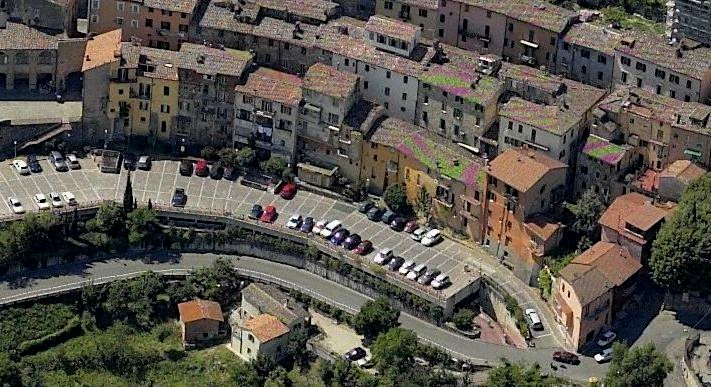
[Merediths window is seen on the top floor of the house in the lower foreground]
Welcome To Common Sense
This briefing was first posted with slightly different opening paras at the start of the annulled Hellmann appeal. New arrivals often tell us this helped them the most.
If you’ve come to this website because of the Amanda Knox book and interview, then welcome. Like all of us who come to this case, you have one key question: did they do it? The Knox book and interview seriously cherrypick the case, and perhaps haven’t helped you at all.
On the Internet, you will find people who are passionate in their defence of Amanda Knox and Raffaele Sollecito; and you will find people who are passionate in their support of an exceptionally talented girl who died, of a fine justice system previously untainted by PR, and of the prosecution’s very strong case.
Please click here for more
Monday, April 08, 2013
Experienced Trial Lawyer: There’s Far More Evidence Than UK/US Courts Need For Guilt
Posted by SomeAlibi
The false claim “there is no evidence”
Some amateur supporters of Knox and Sollecito have committed thousands of hours online to try and blur and obfuscate the facts of the case in front of the general public.
Their goal is simple: to create an overwhelming meme that there is “no evidence” against the accused, and thereby try to create a groundswell of support. Curt Knox and Edda Mellas and Ted Simon have all made this “no evidence” claim many times.
At least some some of the media have eagerly swallowed it.
The amateur PR flunkies make up myriad alternate versions of what created single points of evidence, often xenophobic scare stories designed to trigger emotional reactions, which they hope will be repeated often enough to become accepted as “the truth”.
And where things get really tricky, another time honored tactic is to go on at great length about irrelevant details, essentially to filibuster, in the hope that general observers will lose patience with trying to work it all out.
But time and again we have shown there is actually a great deal of evidence.
Evidence is the raw stuff of criminal cases. Let me speak here as a lawyer. Do you know how many evidence points are required to prove Guilt? One evidence point if it is definitive.
A definitive evidence point
If you’re new to this case or undecided, what is an easy example of ONE definitive evidence item that might stand alone? Might quickly, simply, and overwhelmingly convince you to invest more time into understanding the real evidence, not that distorted by the PR campaign?
In fact we have quite a choice. See the footprint which was second on that list.
Now see the table above. I recommend the use of this table of measurement to avoid the lengthy back and forward of narrative argument which so lends itself to obscuring the truth. I would like to present you with this single table of measurements to give you pause to question whether this line that there is “no evidence” is really true or whether it might be a crafted deception.
I present here a summarized view of critical evidence which suggests with devastating clarity that Raffaele Sollecito was present the night of the murder of Meredith Kercher. No lengthy text, no alternate versions, just measurements.
This FIRMLY places Sollecito in the very room where Meredith was attacked and killed.
In the small bathroom right next to Meredith’s bedroom was a bathmat. On it was found a bloody naked right footprint of someone walking straight towards the shower in the bathroom. The blood is that of Meredith.
The footprint is not Amanda Knox’s - it is too big - but we can compare it to the prints taken of Rudy Guede and Raffaele Sollecito.
In Judge Massei’s report the multiple measurements were detailed in the narrative over many sentences and, in that form, their immediate cumulative impact is less obvious. It is only by tabulating them, that we are forcefully hit by not one but two clear impressions:
The measurements are extremely highly correlated to the right foot of Raffaele Sollecito in twelve separate individual measurements. In themselves they would be enough for a verdict of guilt in all but a few court cases.
But they also show a manifest LACK of correlation to the right foot of Rudy Guede, the only other male in that cottage on the night. Have a look for yourself.
If you were the prosecution, or indeed the jury, and you saw these measurements of Raffaele’s foot versus the print, what would you think? Answer the question for yourself based on the evidence admitted to court.
Then, if you compare further, exactly how plausible do you find it that the measurements of the bloody imprint are Rudy Guede’s instead?
Not only are some of the individual measurements of Rudy’s imprint as much as 30% too small, but the relative proportions of length and breadth measurements are entirely wrong as well, both undershooting and overshooting by a large margin (70% to 150%).
Conclusions that must follow
Presented with those numbers, would you consider those measurements of Rudy Guede’s right foot to show any credible correlation to those of the footprint on the mat?
Supporters of the two have tried frantically to create smoke screen around this - the wrong technique was used they say (ruled not so by the court) / they are the wrong measurements (all 32 of them? that Raffaele’s are matching exactly or within a millimetre but Rudy’s are out by as much as -30% to +50%...?).
The severity of the impact on the defence is such that there was even a distorted photoshopped version circulated by online supporters of Raffaele and Amanda until they were caught out early on in coverage. But it is hopeless, because these are pure measurement taken against a scale that was presented in court and the data sits before you.
Have a look at the measurements and understand this was evidence presented in court. Whose foot do you think was in that bathroom that night? Rudy Guede? Or was it Raffaele Sollecito on twelve counts of measurement?
And if you find for the latter, you must consider very seriously what that tells you both about the idea there is “no evidence” in this case and who was in the cottage that night…

